Remember that angry email to your colleague you regretted the instant you sent it?
What about losing your cool at the meeting and saying those words you probably didn’t even mean?
Is there a magic word that can make your mistake go away and mend the relationship with the wronged person?
What about ‘sorry’?
Does ‘sorry’ really seem to be the hardest word, as Elton John once sang?
Actually, since conflict and/or mistakes are inevitable, an effective apology is one of the most important tools in workplace communication. Still, a simple ‘sorry’ might just not be enough.
As human beings, we have the need for reconciliation — which is why in this blog post, we’ll deal with apologizing.
First, we’ll consider the importance of apologizing at work.
Then, we’ll imagine scenarios in which we haven’t apologized at work — and analyze the consequences of that unfortunate decision.
After that, we’ll dissect an effective apology.
In the end, we’ll give you some tips on how to apologize at work (including useful phrases you can use).
Let’s dive into it!
Table of Contents
Why is it important to apologize at work?
I’ll give you two answers — a relatively short one and a longer one, with a few specific reasons.
Let’s start with the relatively short one.
According to the research article on conciliatory gestures, mammals are especially prone to use “conciliatory gestures” to signal their desire to end conflict and restore peace with other parties after the conflict.
As mammals, we tend to have similar psychology, according to McCullough, one of the authors of this research.
In other words, it’s in our nature to apologize and restore peace.
If this is not enough, here comes the longer answer, with specific reasons.
By saying ‘sorry’ you show others that you acknowledge your actions
Let’s say you were late for an important meeting. You prepared a presentation for your clients about the new features of the software you’re developing, but there wasn’t enough time to make your presentation. Your clients were dissatisfied with your unprofessional behavior and opted out of the deal. Your colleagues were mad at you, and rightly so, because your tardiness directly affected the project you’re working on together.
A pretty grim situation, right?
Yes, but there is a five-letter-word solution — Sorry.
If you apologize to your colleagues for being late, you take responsibility for your actions and show your coworkers that you are aware that it affects the project.
By saying ‘sorry’ you rebuild trust
When with certain transgressions you break trust among your colleagues, the road to redemption is paved with apologies.
The previously mentioned research shows us that “the extent to which a transgressor offered conciliatory gestures to their victims was directly proportional to the extent to which those victims forgave over time.”
These gestures change the victim’s perception of the transgressor and influence their relationship, improving the trust among coworkers.
Here’s what neuropsychologist Alexander Burgemeester had to say about this type of trust:

“Although it can be uncomfortable, it is important to always own up to something you may not have been right about if it affects another coworker. It is also important to remember that you are not less of a person because you are apologizing, and it actually makes you much more respected.”
By saying ‘sorry’ you decrease workplace stress
If you’re already stressed, you don’t need other sources of stress that would worsen your condition. And, you’re not alone.
According to a survey, The Workplace and Stress, conducted by the Harvard T.H. Chan School of Public Health, one in five working adults experience a great deal of stress at work.
So, if your actions have upset your colleagues (and, chances are, they have), apologizing might just be the way to decrease any workplace stress.
💡 Pumble Pro Tip
If you want to discover more ways of decreasing stress at the workplace, check out our in-depth article on wellness ideas for remote employees:
By saying ‘sorry’ you improve communication
Restoring peace in the workplace leads to better understanding and more open interpersonal communication in the future.
If we keep in mind that, according to a McKinsey report, productivity increases by 20–25% in teams that communicate effectively, it’s easy to see why it’s important to mend workplace relationships by apologizing for your mistakes.
—
Now that we’ve seen the benefits of apologizing at work, let’s consider what can happen if we don’t apologize.
What can happen if you don’t apologize at work?
If saying ‘sorry’ has so many benefits for your workplace communication and collaboration, why do we sometimes avoid apologizing?
Here’s what Dr. Michael Barbera, a consumer psychologist and a business strategy consultant, had to say about this problem:

“An effective apology could mend an issue and enhance a relationship.
Social science researchers hypothesize there are three barriers to a transgressor’s apology:
- Potentially reduced levels of concern for the victim,
- A perception that apologizing could threaten the transgressor’s self-image, and
- A belief that apologizing could be ineffective at obtaining forgiveness.”
If you don’t overcome these barriers, there are possible direct consequences on your workplace atmosphere, such as:
- Poor relationships — If you don’t apologize for your mistake, you might damage your relationship with your coworkers, which directly affects the work environment and productivity.
- Career limitations — Not apologizing for your mistakes at work might cost you that long-awaited promotion. Managers may not recommend you for a higher position because, by neglecting apologies, you’re showing that you’re not such a great team player and that you don’t own up to your mistakes.
- Incorrect impressions — You don’t want to leave the impression of being a difficult person. If you don’t apologize for your mistake, a negative impression is a given.
—
It’s time to get acquainted with the anatomy of an effective apology.
6 components of an effective apology
Before we give you tips on how to apologize at work, we should consider the main components of an effective apology.
In their article, An Exploration of the Structure of Effective Apologies, Roy J. Lewicki, Beth Polin, and Robert B. Lount Jr. claimed that “the composition of an apology matters. The structure of these narratives — in other words, the consideration of both format and content — affects perceptions of the transgressor.”
Furthermore, they argue that a maximally effective apology should consist of 6 components:
- An expression of regret — Instead of insisting that ‘it’s not your fault’, show regret for your mistake.
- An explanation for why the offense occurred — Instead of an excuse, offer an explanation. Simply, explain how things went wrong.
- An acknowledgment of responsibility — Admit your responsibility, without justifying yourself, and show that you are willing to do better in the future.
- A declaration of repentance — Show your coworkers that you’re truly sorry for the mistake you’ve made.
- An offer of repair — To avoid giving the wrong impression that you’re uncaring, offer to make up to your colleagues — e.g. by working longer hours or offering to fix any caused issues. That shows your coworkers that you’re willing to make amends.
- A request for forgiveness — We’re not saying you should beg for forgiveness, but rather ask for an opportunity to show everyone that you can change your ways.
—
Now that we’re familiar with the structure of an effective apology, it’s time for some more specific tips that will help you in your workplace communication.
How to apologize at work
An effective apology at work goes a long way and contributes to healthy workplace culture, to which we all strive.
We’ve already analyzed the main components of an effective apology.
Now, all that’s left for us to do is give you some specific tips on how to make your apology even more effective.
Let’s start.
Apologize soon after the incident
In 1992, the Vatican officially apologized to Galileo. Moreover, the pope agreed that the Earth revolves around the Sun.
That’s admirable.
The only minor problem with this apology is that it came more than three centuries too late.
To avoid these kinds of cardinal mistakes when apologizing, make sure you do it soon after the incident.
That shows to your coworkers that you regret your actions, that you’re aware of the consequences of your transgressions, and that you want to make amends.
However, if your transgression was a bit more serious, it’s better to wait for everyone to cool their heads, and only then proceed with the apologies.
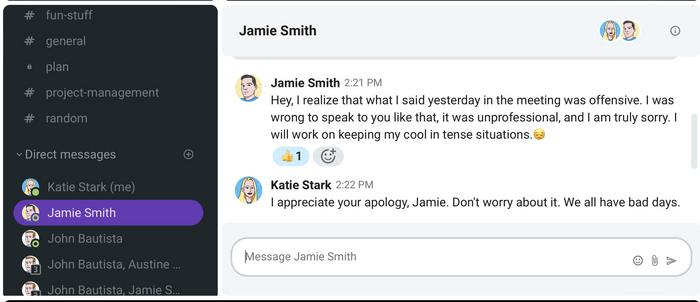
Decide how you’ll apologize
When apologizing, make sure you pay attention to both your verbal and body language.
Use the words ‘I’m sorry’ or ‘I apologize’, and, if possible, apologize privately.
Whatever you do, make sure you omit any justifications, as well as the words “if” or “but”.
For example, refrain from apologies such as these ones:
“I’m sorry if I hurt your feelings during the meeting.”
Or
“I’m sorry I made a mistake, but you knew I didn’t have enough time to finish the project.”
A consumer psychologist and a business strategy consultant Michael Barbera even advised us to skip the words “I am sorry” altogether, as they have become a complacent phrase:

“For example, if I accidentally bump into your shoulder, I would likely say ‘I am sorry.’
These words have reduced meaning; therefore, ‘I apologize’ or ‘my apologies’ are likely to be more effective.”
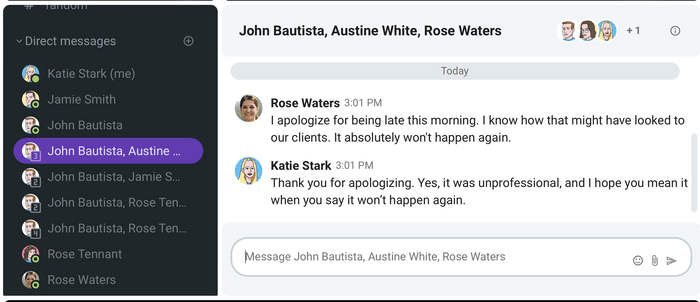
Address your recipient by name
Addressing the recipient of your apology by name is respectful, and it shows that you’re aware that your actions have affected them directly.
Altogether, addressing them by name improves the overall workplace atmosphere.
Aside from that, it adds to the sincerity.
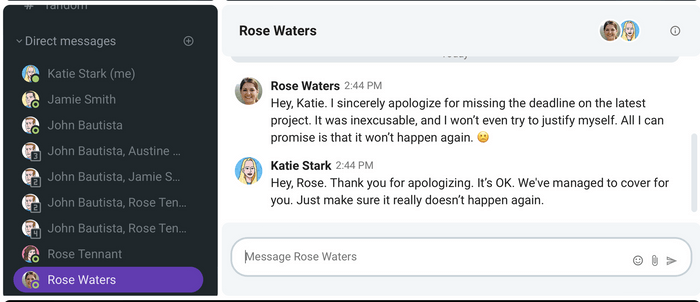
This leads us to our next tip.
Apologize with sincerity
If you want to deliver a sincere apology, first, you should try to understand how the other person feels.
Empathy is the keyword here.
If you don’t understand where you went wrong, it’s best to first discuss your transgression with the wronged party.
Maybe then you’ll both understand each other better. If you can acknowledge your part in the problem, you’ll be able to sincerely apologize for your mistake.
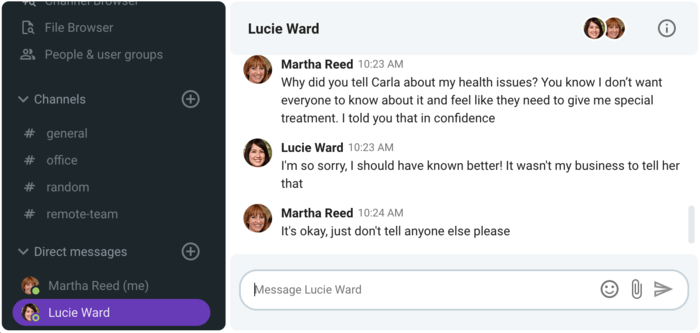
Validate how the other person feels
Always make sure you take the other person’s feelings into account.
It’s essential to acknowledge their feelings and, if possible, include them in your apology, as in the example from the business messaging platform Pumble below.
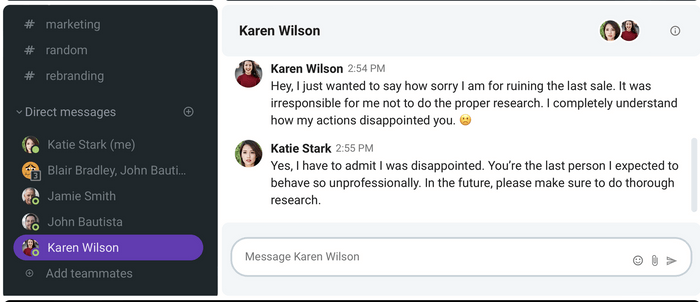
Burgemeester also places a great value on validating other people’s feelings when apologizing:

“You should always acknowledge the other person’s feelings as well and give them a chance to speak. You can also ask for their forgiveness as you want the relationship to not be hindered by what happened.”
Admit to your responsibility (focus on your own actions)
This one’s maybe the hardest one — take responsibility for your actions.
Nobody wants to be wrong, but the truth is — nobody can always be right.
Whatever you do, when apologizing, don’t make excuses (even if you believe they are valid).
It’s only natural to want to explain what happened, but don’t forget the crucial part of your apology — showing them that you’re aware of your mistake and that you’re sorry.
Aside from all the above-mentioned benefits, this step shows your colleagues that you won’t repeat the same mistakes.
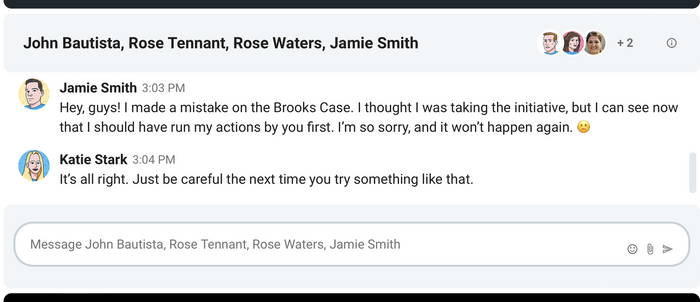
Explain how you’ll correct your mistake
When apologizing to your colleagues, don’t forget to mention how you’ll correct your mistake. This shows that you have thought about how you can make things right.
Aside from that, you can show your coworkers you don’t intend to make the same mistake again.
However, be realistic with your promises, if you want to keep them.
For example, don’t promise them you won’t ever be late for work again — you cannot possibly know whether you can keep that promise.
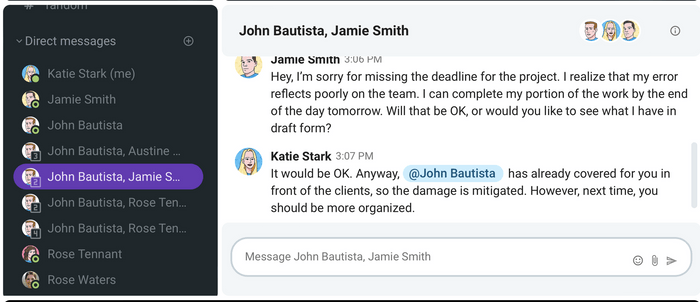
Keep your promises
After you’ve explained your plan for fixing the mistake you made, make sure you keep those promises.
By doing that, you’re showing your coworkers that you’re sincere and committed to maintaining and improving your professional relationship with them.
On the other hand, if you fail to keep your promises, you risk losing your team’s trust, not to mention how unprofessional that might seem to clients.
However, if you keep your promise, it will surely be appreciated by your team.

—
We’ve guided you through 8 steps towards an effective apology, but our work isn’t over just yet.
In the following paragraphs, we will provide you with some useful phrases for apologizing at work.
By the end of this post, you’ll be fully equipped to effectively apologize.
How to say sorry without saying sorry
Oftentimes, we use the word ‘sorry’ in the workplace too many times. We apologize if someone bumps into us in the office, or if we are trying to squeeze our way to lunch.
Over time, the word ‘sorry’ loses its meaning. When we do need to apologize and get our sincerity across, the word ‘sorry’ seems like it’s not enough.
So, let’s talk about some of the ways how you can say sorry, without actually using the word ‘sorry’.
Tip #1: Deliver your apology while omitting the word ‘sorry’
This one might seem a little too much on the nose, but consider giving the same apology and omitting the word ‘sorry’.
Since we established that ‘sorry’ is overplayed and, in the end, it only shows low self-esteem, your apology would be of stronger effect and more sincerity if you just go straight to the point.
Here’s a suggestion:
“I realize I have made a mistake, and I am working hard to fix it immediately.”
Tip #2: Show gratitude instead of remorse
Standing in your power and showing confidence is also the key to a good and heartfelt apology.
We have heard shaky ‘sorries’ far too much around the office.
So instead of apologizing for missing a deadline, for example, show gratitude for getting an extension.
For instance:
“Thank you for agreeing to give me an extension on my task.”
Tip #3: Remember that actions trump words
We can all agree that empty words don’t bring anything of value to the table.
When you are trying to fix a mistake, back up your words with immediate action that will show your intention and dedication to rectify the situation.
It’s easy to get caught up in ‘word vomits’. We tend to overcompensate when we are feeling anxious. Take a deep breath, deliver a direct apology and get to work.
For example:
“There’s no excuse for my oversight. Here is how I plan on doing better.”
Tip #4: Never apologize for your existence
A lot of us feel the need to utter the word ‘sorry’ if we are interrupting someone while they work, or if we wish to ask our supervisor a question.
The advice here is to, instead of saying ‘sorry’, just get to the point.
For example, you can ask your colleagues “Do you have a minute”, or “Is now a good time to chat about [xyz]?”
Here’s how that looks:
“If you have a minute I would like to discuss how I can do better on future projects.”
Tip #5: Use the different ways to say sorry
There are a lot of ways to avoid the ‘sorry’ conundrum with simple use of synonyms.
Think of it like this: If we are so keen on repeating the same word over and over again, that same word loses its meaning.
Now, the word ‘sorry’ is overused — but its synonyms are barely heard in the workplace.
Therefore, let’s jump into all the different ways to say sorry and learn together how to exude confidence and remorse at the same time.
Use “I regret” instead of “Sorry”
Using “I regret” instead of saying “Sorry” offers a bigger impact.
This simple phrase can help you make your apology sound more sincere — and it also shows deep remorse for your actions.
We all want our apologies to translate to the other person.
Let’s compare:
- “I’m sorry for missing the deadline.” — This is a good enough apology, we can all understand that you are, well, sorry. But, the impact is barely noticeable.
- “I regret that my actions and me overlooking my mistake made the team look bad.” — When you open your apology with a similar statement, your teammates will feel how much you care about the work and the team.
Use “I apologize” instead of “Sorry”
Although “I apologize” seems quite similar to the phrase “I’m sorry”, the former is a more professional and direct approach.
Stating that you apologize for making a mistake or letting down the team will make room in your apology to explain yourself, and it’s setting up the tone that you are asking for honest forgiveness.
Let’s compare:
- “I’m sorry for my actions…” — While we can all agree that saying ‘sorry’ is a great starting point, oftentimes it’s not enough to showcase the true meaning of your apology. Next time try emphasising your apology with phrases we explain in the next points.
- “I would like to apologize for missing an important meeting” — The catch about the “I apologize” phrase is that you can tone it down, and use it to rectify a small and simple mistake. That can look something like this “I apologize for being late” or “I apologize for missing your call.” You can also expand the phrase, add in your own personal experience, and make a wave of an impression as we showed in our initial example.
Use “Forgive me” instead of “Sorry”
Though this one sounds and feels a tad bit too personal, it can serve you well in the workplace.
Sometimes, adding a personal touch or your true feelings is not a bad idea.
Don’t forget that neither you nor your coworkers are robots.
Too many feelings are not appropriate for the workplace, but a little goes a long way.
To illustrate:
- “I’m sorry for not making a bigger effort.” — It seems that there is always a cloud of professionalism hanging above our heads. Usually, we try to follow the professional code of conduct to a T. But, when it comes to apologies, it’s okay to steer away from the said cloud. If you strive to make a memorable impression, the word ‘sorry’ won’t take you there.
- “Forgive me, my mistake disrupted the flow of our team.” — Using such a phrase leaves the recipient feeling more in touch with your feelings. Coming across as cold or unnerved in your apology won’t translate well to the other person. Usually, showing just enough feelings gives your apology the kick it was missing.
Use “It’s my fault” instead of “Sorry”
Admitting guilt is no easy task. We have to put our pride and ego aside. But being wrong or making a mistake is not the end of the world, so have the confidence to admit your wrongdoings.
So, next time you want to say sorry, try replacing it with “It’s my fault”, and show your colleagues that you understand where you went wrong.
Let’s compare:
- “I’m sorry I flunked the project.” — This apology, for example, will only get you so far. Yes, your co-workers will accept it. Although, you might notice that when we use the word sorry, it sounds insincere. So, while this is a good apology for a friend, try something more impactful for a colleague, like our next example.
- “It’s my fault that the project didn’t go as smoothly as it should have…” — Being honest about your mistakes is always better than to just give a short and impersonal apology. The phrase “It’s my fault” is incredibly effective. When you make notice that it is your fault, and you own up to it, your colleagues will respect you more. This phrase is straightforward, and when you use it, the wronged party is certain that you are sorry for your actions. It will help you deliver a short and direct apology with an impact.
Use “How can I apologize” instead of “Sorry”
Sometimes, apologizing to other people can be tricky. People are different, and if you are not sure how to approach the situation, try asking the person you wronged how you can make it up to them.
Replacing “I’m sorry” with a question such as “How can I apologize” is a great opener to healthy and open communication.
To illustrate:
- “Sorry for not being more discreet. Won’t happen again.” — Personal disagreements can happen even in the workplace. So when you are approaching a colleague that you have wronged, it’s not the best idea to assume that a simple apology will ‘work’. Remember that you sometimes have meaningful relationships with people you work with and honor that.
- “How can I apologize for my indiscretion? I want to mend my mistakes and help us move forward.” — Even if you are not sure how to approach a particular colleague, consider asking them how they would like to receive an apology. As long as you are honest and willing to make amends, questions like this can go a long way.
How to apologize in chat
Remote work is now more prominent than ever, so it should come as no surprise that professional disagreements still happen regularly. Only now, the awkwardness and the usual tension moved from the office to business chats. We can all agree that communication over written words, such as those in chats, can sometimes get misinterpreted.
When we can’t hear someone’s tone, we inject our own. So when miscommunication, misunderstandings, or full-blown disagreements happen in chat — here’s how to apologize.
Tip #1: Be straightforward
In a world where you need to reach someone and make an effect with your apology in chats, getting off topic would be your first mistake. Get straight to the point, be direct and make sure that there is no more room for miscommunication.
For instance:
“I am apologizing for mixing up the dates of the deadline. I will get you the finished product by tomorrow. ”

Tip #2: Use empathy instead of sympathy
When we acknowledge our colleague’s feelings, we can rectify the mistake we have made quicker. Empathy is a great ally to you and to all of us. The more your co-workers feel heard and understood, the better your communication can become.
Although apologizing can be somewhat uncomfortable, when you do it right, the next time you have to admit your mistakes, it will be easier — because your colleagues will understand you.
Here’s an example:
“I realized how my actions made you feel. It was not okay for me to talk about your personal issues with someone else.”
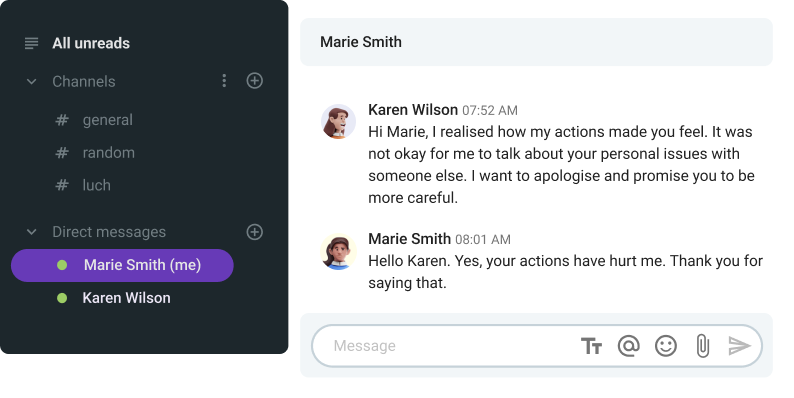
Tip #3: Ask for forgiveness
Oftentimes we forget to ask for forgiveness because we think that it’s implied. Using a simple phrase such as “Please forgive me” will ensure that your apology has a positive outcome. If you are working with a remote worker, try to make the written conversation feel more natural, and think about ending your apology with a request for forgiveness.
An example being:
“I understand how my outburst in the meeting reflected poorly on the whole team. I value your opinion truly. I hope that you can forgive me, and we can move forward. ”
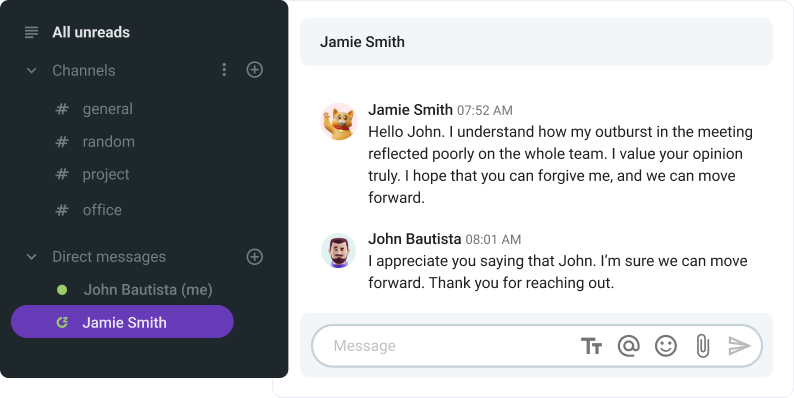
How to apologize in an email
Email and chat are different vessels for the same purpose, communication — the only difference being the level of formality. We mostly use email to contact people outside of our company. So, let’s talk about how to make your apology acceptable for email communication.
The formula is the same in almost every type of apology and communication. So, when you are sending your apologies over email, you can still use the same structure and all the advice you have read about until now.
When apologizing in an email, we have to acknowledge that email is a bit more formal and official than apologizing over chat. You might use chat to apologize to your colleagues and teammates, but consider email if you are reaching out to your supervisors or clients.
Let’s talk about how to deliver a great apology over email.
Email apologies to a client
If you want to send your deepest apologies to a client, keep in mind that you are apologizing on behalf of the whole company. You might be the one that made a mistake and the one that is handling the client communication. But, that doesn’t change the fact that for that client, you are the face of the company.
Your email should hold the same formula as we have talked about before. But remember to hold your apology to a new degree of professionalism and formality.
Tip #1: Admit the mistake
When you are sending a client an apology email, use the right salutations and make sure that your remorse is visible.
Here’s our advice on how to start off:
Open up with a sentence that shows you have noticed and regretted your mistake. If, for example, you are writing to your client about missing an important meeting or deadline, try something along the lines of:
“Dear client,
We have taken into account our poor actions, and we have taken an initiative to make up for the lost time.”
Tip #2: Don’t overexplain
A good thing to do is to keep your email short and sweet. There is no need to send a 3-page apology email if the client won’t read it. Your words need to reflect on the situation in a clear way.
So while your client is reading it, they should understand that you and the company don’t shy away from admitting guilt and are willing to work on bettering the relationship you have established.
Such as:
“We realize that there were shortcomings on our part. There is no excuse for missing our meeting.”
Tip #3: Don’t forget to show gratitude and ask for forgiveness
A great way of ending your apology email is with a thank you note. Since you are the one who is making an apology, a little gratitude for understanding goes a long way.
This is one of the paths you could take:
“We ask you for your forgiveness, and we hope that this won’t affect the future of our relationship. Thank you for understanding.”
15 Useful phrases for apologizing at work
All that’s left for us is to give you some useful phrases for apologizing that will help you become a more skilled communicator and a more considerate colleague.
Without further ado, here they are:
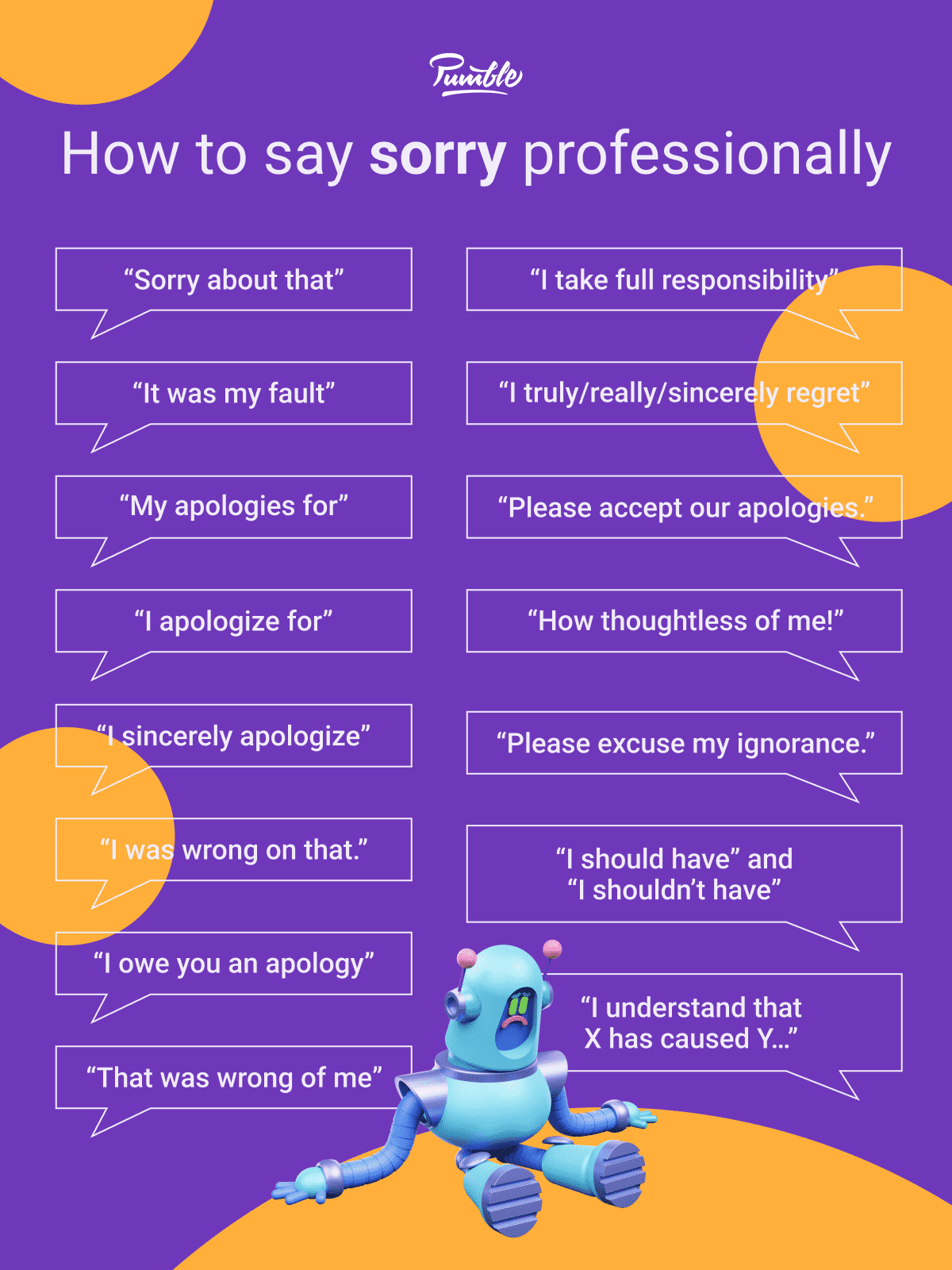
- “Sorry about that” — for minor mistakes
“Looks like I gave you the wrong email address. Sorry about that.”
-
“It was my fault” — for a little more serious mistakes
“It was my fault that we didn’t meet the deadline.”
-
“I take full responsibility” — when you caused the problem
“I take full responsibility for failing to train the interns properly.”
-
“My apologies for” — for all kinds of mistakes
“My apologies for keeping you waiting. I’m running a little late today.”
-
“I apologize for” — for all kinds of mistakes
“I apologize for keeping you on the phone for so long. I know you are busy.”
-
“I owe you an apology” — to open a conversation about apologizing
“I owe you an apology. I said some horrible things to you.”
-
“I should have” and “I shouldn’t have” — to talk about what the correct/right action would have been (which you didn’t do)
“I shouldn’t have taken your computer mouse. I should have asked you first.”
-
“That was wrong of me” — to express that your action was not morally correct
“I gave you the silent treatment, and that was wrong of me.”
-
“I truly/really/sincerely regret” — to express that you feel very bad about what you did, and you wish you had behaved differently
“I truly regret my offensive comments.”
-
“I sincerely apologize” — for all kinds of mistakes
“Our website is not working properly. I sincerely apologize for the inconvenience.”
-
“Please accept our apologies.” — for all kinds of mistakes
“We have forgotten about the meeting. Please accept our apologies.”
-
“I understand that X has caused Y…” — for apologizing for something you didn’t directly cause, but was the result of system malfunction or some other technical error
“I understand that the blackout has caused major inconvenience for you. We’re fixing the problems as we speak.”
-
“I was wrong on that.” — for apologizing for incorrect information
“The meeting is actually on Friday, not on Thursday. I was wrong on that.”
“How thoughtless of me!” — for criticizing ourselves for the mistake we’ve made
-
“Please excuse my ignorance.” — for apologizing for our lack of knowledge or abilities
“Please excuse my ignorance, but what exactly is a hotfix?”
“I completely forgot that James just got fired and asked him if he were going to the team building next month. How thoughtless of me!”
Change the way you communicate: Use Pumble to send your apologies
Learning how to properly say “I’m sorry” at work can completely transform the way you communicate with your coworkers — and so can Pumble, the all-in-one communication and collaboration app.
If your team uses Pumble, you’ll be able to quickly and easily send professional apologies (and much more) to your coworkers.
Pumble lets you communicate with others via:
- DMs,
- Group messages,
- Dedicated channels,
- Scheduled messages,
- Audio calls, and
- Video conferences.
So, when a mistake happens (which hopefully won’t be too often), you’ll have plenty of opportunities to follow our 8 tips for crafting the perfect professional apology!




